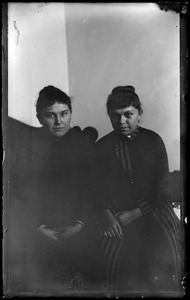Holyoke Public Library
C.R. Wilhelm Collection

Detail from:
Pa at Ashley Pond, 1899
Carl Robert Wilhelm was born in 1857 in Crimmitschau, Saxony, a hub of the German textile industry. After studying in Würzburg, Wilhelm continued the family tradition and became a skilled textile worker in his home city. Following travels in Europe, Wilhelm immigrated in 1884 to the United States. He worked first at Holyoke’s Munn & Bausch machine shop and then at Germania Mills, the woolen mill at South & Race Streets owned by German immigrants Hermann and August Stursberg. “A genius with machinery,”* Wilhelm quickly advanced to the position of master mechanic. In the 1890s, he left the mill for several years and opened a bottling business with a partner, Lambert Derichs. They sold carbonated spring water, promoting its medicinal properties. After Derichs moved on, Wilhelm briefly ran a saloon with another partner before returning as a master mechanic to Germania Mills. Wilhelm married Franziska Greunert in 1888. They raised four children, Erna, Fredrick, Mabel, and Robert, in their home on Charles Street in Holyoke.
An avid amateur photographer, Wilhelm made glass plate negatives and prints of many subjects close to hand: family and friends, streets and cityscapes, mills and businesses. Comfortably middle class, like many in Holyoke’s German immigrant community (which numbered about 3000 at its peak), Wilhelm also photographed the leisure activities of his social circle: music-making, hiking, fishing, bicycling, and shooting. The images provide an intimate portrait of German immigrant family and social life in Holyoke from roughly 1890 to 1920. While similar in content to the snapshots of a later era, some images appear to show signs of Wilhelm’s experimentation with light and remote control devices.
C. Robert Wilhelm died in 1940. The glass plate negatives were found by Wilhelm’s great-grandson in a wooden soda bottle crate in the family home in Holyoke in 1975. He donated them to the Holyoke History Room in 2014. It is the donor’s wish that when items from the collection are shared, they be identified as belonging to the C.R. Wilhelm Collection.
*Holyoke Transcript-Telegram editorial, 12 April 1940.
An avid amateur photographer, Wilhelm made glass plate negatives and prints of many subjects close to hand: family and friends, streets and cityscapes, mills and businesses. Comfortably middle class, like many in Holyoke’s German immigrant community (which numbered about 3000 at its peak), Wilhelm also photographed the leisure activities of his social circle: music-making, hiking, fishing, bicycling, and shooting. The images provide an intimate portrait of German immigrant family and social life in Holyoke from roughly 1890 to 1920. While similar in content to the snapshots of a later era, some images appear to show signs of Wilhelm’s experimentation with light and remote control devices.
C. Robert Wilhelm died in 1940. The glass plate negatives were found by Wilhelm’s great-grandson in a wooden soda bottle crate in the family home in Holyoke in 1975. He donated them to the Holyoke History Room in 2014. It is the donor’s wish that when items from the collection are shared, they be identified as belonging to the C.R. Wilhelm Collection.
*Holyoke Transcript-Telegram editorial, 12 April 1940.
